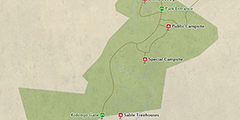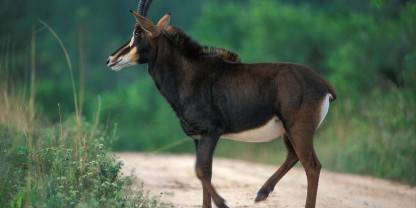Shimba Hills National Reserve is the closest safari destination to Mombasa and the beach resorts that line Kenya’s south coast. It protects one of East Africa’s largest coastal rainforests as well as patches of rolling grassland. Wildlife includes Kenya’s only remaining population of the handsome sable antelope, along with elephant, buffalo and a variety of antelope, monkeys and forest birds. A popular activity is the short guided hike to Sheldrick Falls.

-
Best Time To Go
- July to September and January to February (Best wildlife viewing)
-
High Season
- December to March and July to October (Not busy)
-
Size
- 300km² / 116mi²
-
Altitude
-
119-442m /390-1,450ft
 View Photos
View Photos
 View Photos
+23
Photos
View Photos
+23
Photos
 Open Map
Open Map
Pros & Cons
- Protects a large area of coastal rainforest
- Rare forest wildlife
- A good chance of spotting buffalo and elephant
- It is little visited and seldom gets busy
- Free guided walks to Sheldrick Falls
- Stunning scenery
- Excellent birding with forest specials
- Easy day trip from Mombasa, Diani and other southern beach resorts
- The only large carnivores are leopard and spotted hyena, but both are very rarely seen
- Accommodations are limited to one lodge, a few self-catering bandas and camping
Wildlife
Shimba Hills doesn’t support the huge variety of plains wildlife associated with Kenya’s larger parks. However, you should see buffalo, sable antelope, bushbuck, yellow baboon, warthog and, with a bit of luck, elephant. The park is a refuge for many forest species, notably Harvey’s red duiker, Angola colobus, and red-tailed monkey. Delightful smaller inhabitants include red-bellied coast squirrel and greater galago, both of which have become habituated at Shimba Hills Lodge.
More about Shimba Hills’ wildlifeScenery
Shimba Hills boasts one of the most diverse ecosystems along the Kenyan coast, with more than 1,000 plant species recorded. Much of the reserve is covered in lush coastal rainforest, a habitat that is poorly represented elsewhere in Kenya. There are also areas of grassland, woodland and coastal bush. Several viewpoints on the eastern ridge of the hills offer views of the Indian Ocean. The ridge is also home to the pretty Sheldrick Falls.
Activities
Guided and self-guided are the main activity. Marere Circuit is a good place to look for elephant and sable antelope. Free guided walks to Sheldrick Falls leave at 10 AM and 2 PM and take up to 2 hours. You can stand below the waterfall for a chilly massage. Stop for lunch or a drink at Shimba Hills Lodge, where red-bellied coast squirrels clamber around the woodwork and elephants sometimes drink at the forest-fringed .
Weather & Climate
An ever-present breeze tends to take the sting out of Shimba Hills’ heat and humidity, though it never really gets that cool. Even at night it stays warm. You can’t fully escape the rain here, but it’s more widespread in October and November, and it can really rain hard in April and May. Sunny days are typical during the dry periods in between.
More about the weather and climateBest Time To Visit
The drier months from July to September and January to February are the ideal time to visit. This is when animals gather around local water sources, making them easy to find. You can still track them in the wetter months, but it takes greater effort as they’re more dispersed. You won’t really be bothered by other visitors here at any time of year, as the park doesn’t tend to attract crowds. However, on busy days, the guided walk to Sheldrick Falls might attract a couple of dozen participants.
More about the best time to visit



